Chronic Kidney Disease in Tiwi Islands
VerifiedAdded on 2023/01/05
|12
|2793
|91
AI Summary
This article discusses chronic kidney disease in Tiwi Islands and the nursing management plan for patients. It explores the reasons for Glenda's transfer back to Tiwi Islands and the potential risks associated with peritoneal dialysis. Find study material and assignments on Desklib.
Contribute Materials
Your contribution can guide someone’s learning journey. Share your
documents today.
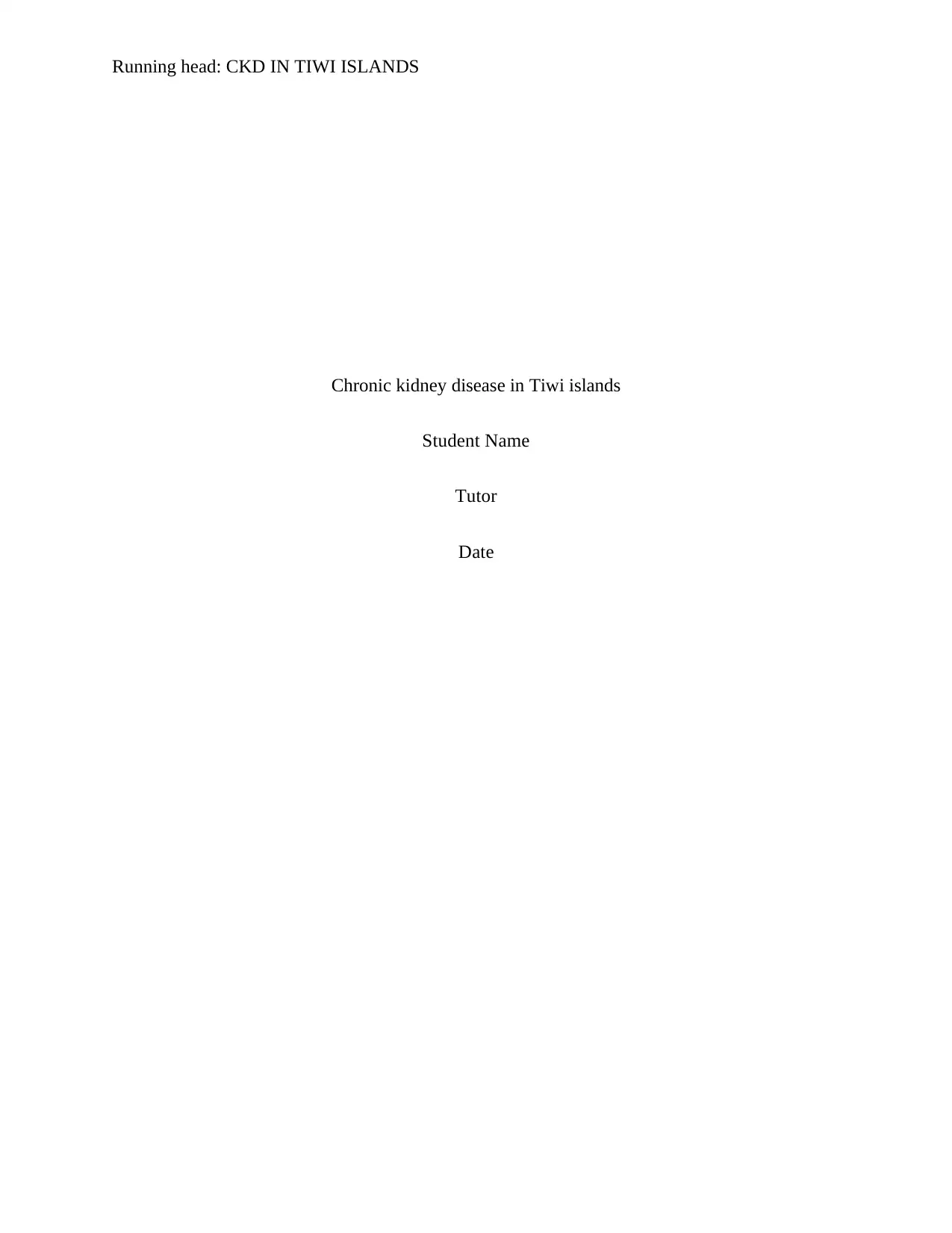
Running head: CKD IN TIWI ISLANDS
Chronic kidney disease in Tiwi islands
Student Name
Tutor
Date
Chronic kidney disease in Tiwi islands
Student Name
Tutor
Date
Secure Best Marks with AI Grader
Need help grading? Try our AI Grader for instant feedback on your assignments.
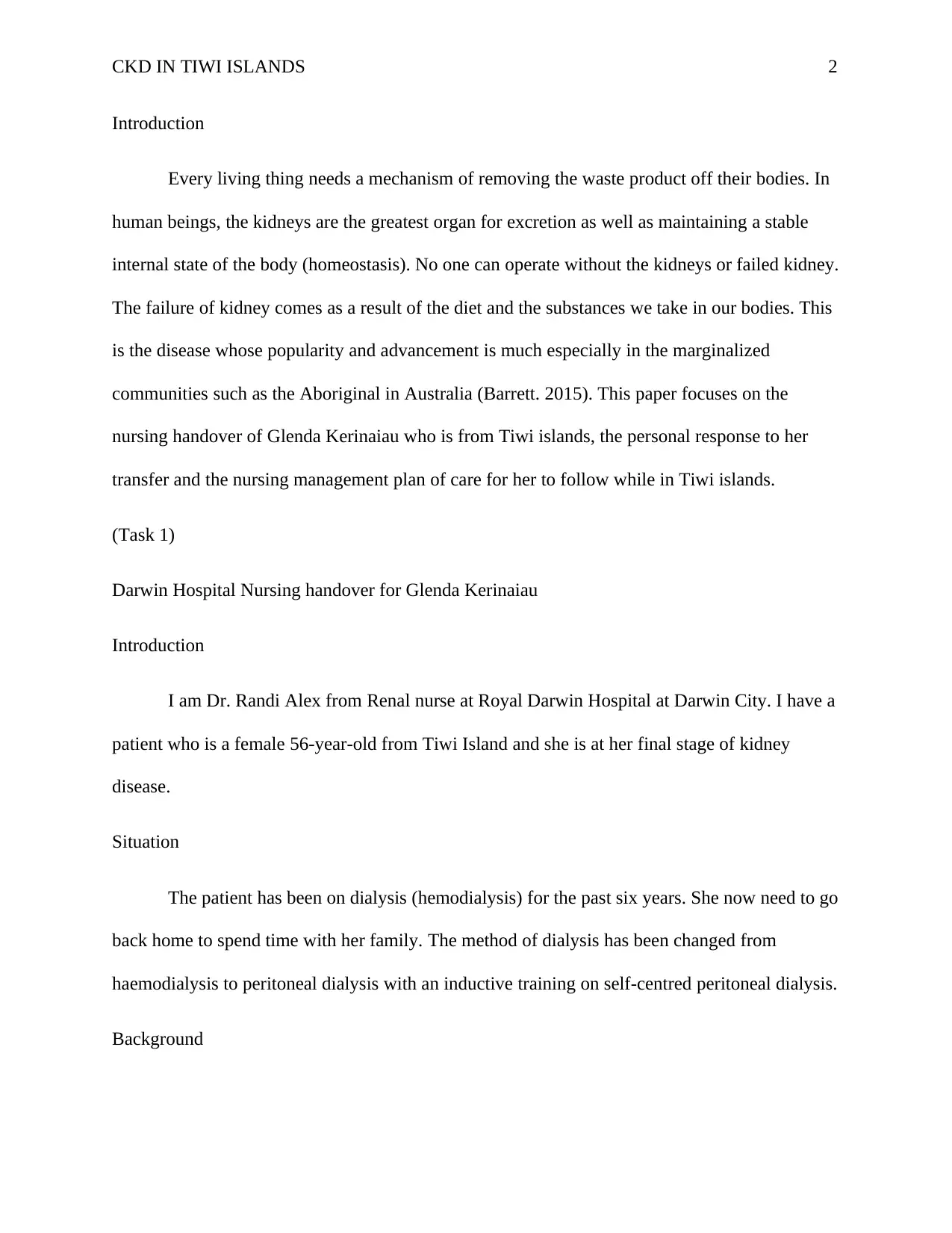
CKD IN TIWI ISLANDS 2
Introduction
Every living thing needs a mechanism of removing the waste product off their bodies. In
human beings, the kidneys are the greatest organ for excretion as well as maintaining a stable
internal state of the body (homeostasis). No one can operate without the kidneys or failed kidney.
The failure of kidney comes as a result of the diet and the substances we take in our bodies. This
is the disease whose popularity and advancement is much especially in the marginalized
communities such as the Aboriginal in Australia (Barrett. 2015). This paper focuses on the
nursing handover of Glenda Kerinaiau who is from Tiwi islands, the personal response to her
transfer and the nursing management plan of care for her to follow while in Tiwi islands.
(Task 1)
Darwin Hospital Nursing handover for Glenda Kerinaiau
Introduction
I am Dr. Randi Alex from Renal nurse at Royal Darwin Hospital at Darwin City. I have a
patient who is a female 56-year-old from Tiwi Island and she is at her final stage of kidney
disease.
Situation
The patient has been on dialysis (hemodialysis) for the past six years. She now need to go
back home to spend time with her family. The method of dialysis has been changed from
haemodialysis to peritoneal dialysis with an inductive training on self-centred peritoneal dialysis.
Background
Introduction
Every living thing needs a mechanism of removing the waste product off their bodies. In
human beings, the kidneys are the greatest organ for excretion as well as maintaining a stable
internal state of the body (homeostasis). No one can operate without the kidneys or failed kidney.
The failure of kidney comes as a result of the diet and the substances we take in our bodies. This
is the disease whose popularity and advancement is much especially in the marginalized
communities such as the Aboriginal in Australia (Barrett. 2015). This paper focuses on the
nursing handover of Glenda Kerinaiau who is from Tiwi islands, the personal response to her
transfer and the nursing management plan of care for her to follow while in Tiwi islands.
(Task 1)
Darwin Hospital Nursing handover for Glenda Kerinaiau
Introduction
I am Dr. Randi Alex from Renal nurse at Royal Darwin Hospital at Darwin City. I have a
patient who is a female 56-year-old from Tiwi Island and she is at her final stage of kidney
disease.
Situation
The patient has been on dialysis (hemodialysis) for the past six years. She now need to go
back home to spend time with her family. The method of dialysis has been changed from
haemodialysis to peritoneal dialysis with an inductive training on self-centred peritoneal dialysis.
Background
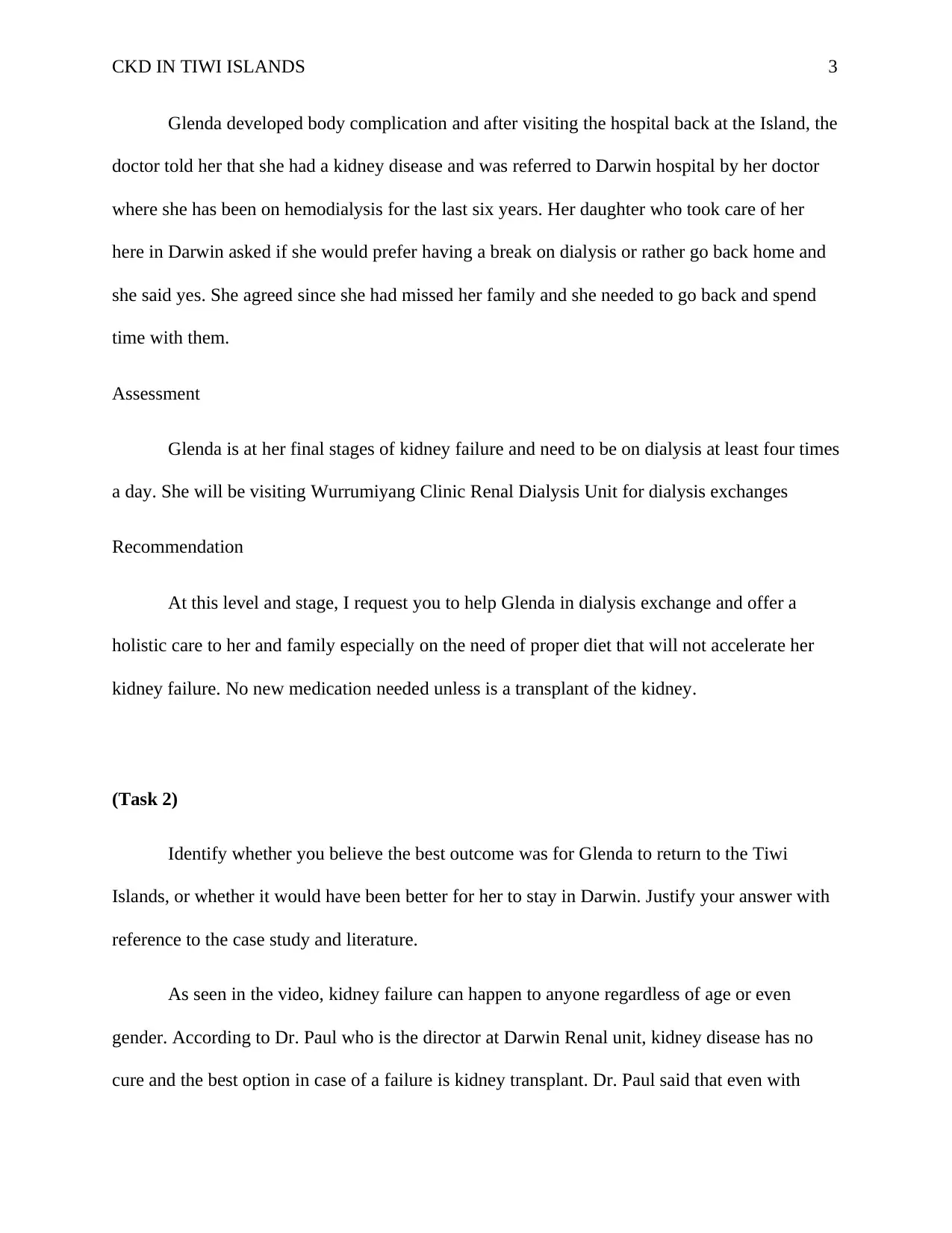
CKD IN TIWI ISLANDS 3
Glenda developed body complication and after visiting the hospital back at the Island, the
doctor told her that she had a kidney disease and was referred to Darwin hospital by her doctor
where she has been on hemodialysis for the last six years. Her daughter who took care of her
here in Darwin asked if she would prefer having a break on dialysis or rather go back home and
she said yes. She agreed since she had missed her family and she needed to go back and spend
time with them.
Assessment
Glenda is at her final stages of kidney failure and need to be on dialysis at least four times
a day. She will be visiting Wurrumiyang Clinic Renal Dialysis Unit for dialysis exchanges
Recommendation
At this level and stage, I request you to help Glenda in dialysis exchange and offer a
holistic care to her and family especially on the need of proper diet that will not accelerate her
kidney failure. No new medication needed unless is a transplant of the kidney.
(Task 2)
Identify whether you believe the best outcome was for Glenda to return to the Tiwi
Islands, or whether it would have been better for her to stay in Darwin. Justify your answer with
reference to the case study and literature.
As seen in the video, kidney failure can happen to anyone regardless of age or even
gender. According to Dr. Paul who is the director at Darwin Renal unit, kidney disease has no
cure and the best option in case of a failure is kidney transplant. Dr. Paul said that even with
Glenda developed body complication and after visiting the hospital back at the Island, the
doctor told her that she had a kidney disease and was referred to Darwin hospital by her doctor
where she has been on hemodialysis for the last six years. Her daughter who took care of her
here in Darwin asked if she would prefer having a break on dialysis or rather go back home and
she said yes. She agreed since she had missed her family and she needed to go back and spend
time with them.
Assessment
Glenda is at her final stages of kidney failure and need to be on dialysis at least four times
a day. She will be visiting Wurrumiyang Clinic Renal Dialysis Unit for dialysis exchanges
Recommendation
At this level and stage, I request you to help Glenda in dialysis exchange and offer a
holistic care to her and family especially on the need of proper diet that will not accelerate her
kidney failure. No new medication needed unless is a transplant of the kidney.
(Task 2)
Identify whether you believe the best outcome was for Glenda to return to the Tiwi
Islands, or whether it would have been better for her to stay in Darwin. Justify your answer with
reference to the case study and literature.
As seen in the video, kidney failure can happen to anyone regardless of age or even
gender. According to Dr. Paul who is the director at Darwin Renal unit, kidney disease has no
cure and the best option in case of a failure is kidney transplant. Dr. Paul said that even with
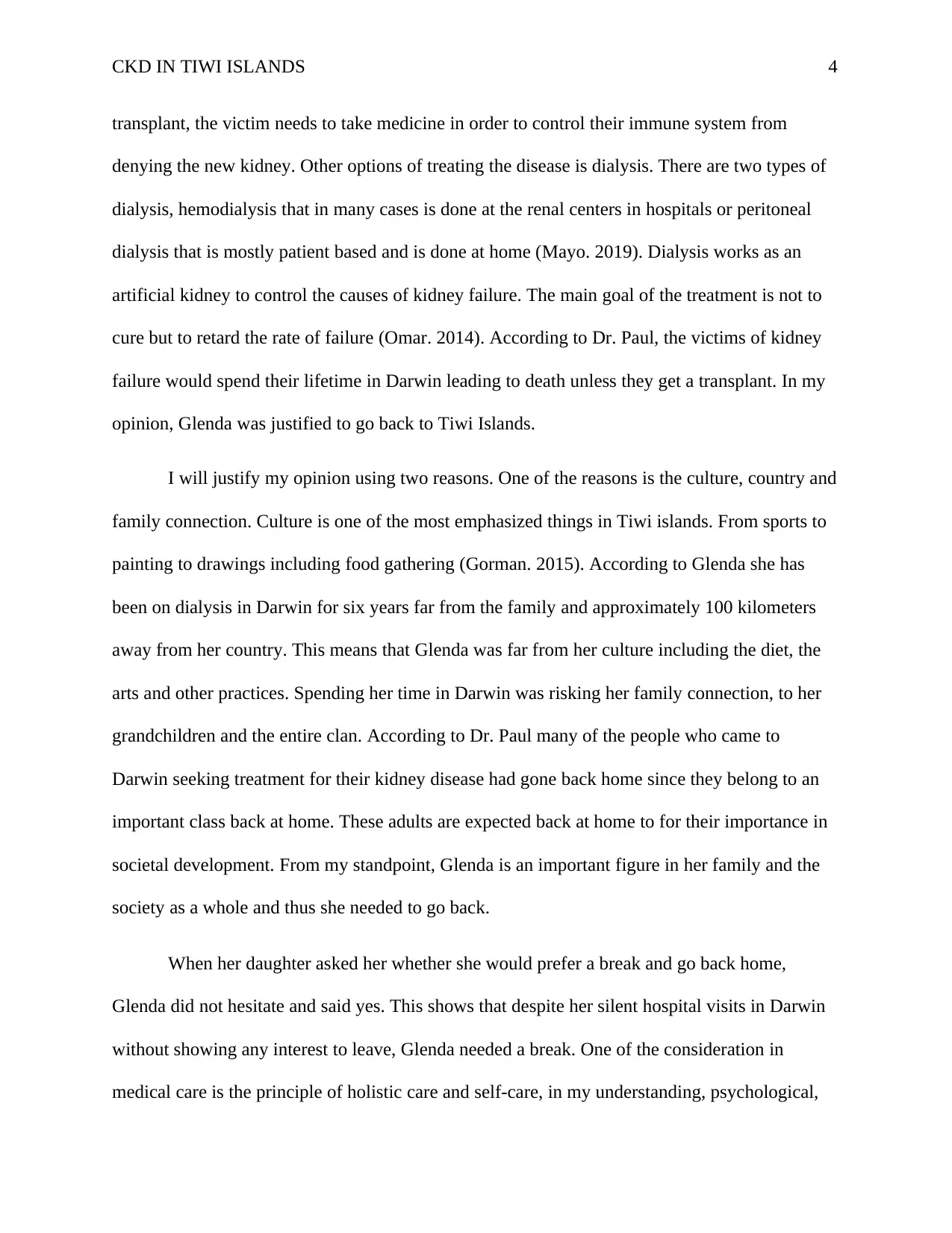
CKD IN TIWI ISLANDS 4
transplant, the victim needs to take medicine in order to control their immune system from
denying the new kidney. Other options of treating the disease is dialysis. There are two types of
dialysis, hemodialysis that in many cases is done at the renal centers in hospitals or peritoneal
dialysis that is mostly patient based and is done at home (Mayo. 2019). Dialysis works as an
artificial kidney to control the causes of kidney failure. The main goal of the treatment is not to
cure but to retard the rate of failure (Omar. 2014). According to Dr. Paul, the victims of kidney
failure would spend their lifetime in Darwin leading to death unless they get a transplant. In my
opinion, Glenda was justified to go back to Tiwi Islands.
I will justify my opinion using two reasons. One of the reasons is the culture, country and
family connection. Culture is one of the most emphasized things in Tiwi islands. From sports to
painting to drawings including food gathering (Gorman. 2015). According to Glenda she has
been on dialysis in Darwin for six years far from the family and approximately 100 kilometers
away from her country. This means that Glenda was far from her culture including the diet, the
arts and other practices. Spending her time in Darwin was risking her family connection, to her
grandchildren and the entire clan. According to Dr. Paul many of the people who came to
Darwin seeking treatment for their kidney disease had gone back home since they belong to an
important class back at home. These adults are expected back at home to for their importance in
societal development. From my standpoint, Glenda is an important figure in her family and the
society as a whole and thus she needed to go back.
When her daughter asked her whether she would prefer a break and go back home,
Glenda did not hesitate and said yes. This shows that despite her silent hospital visits in Darwin
without showing any interest to leave, Glenda needed a break. One of the consideration in
medical care is the principle of holistic care and self-care, in my understanding, psychological,
transplant, the victim needs to take medicine in order to control their immune system from
denying the new kidney. Other options of treating the disease is dialysis. There are two types of
dialysis, hemodialysis that in many cases is done at the renal centers in hospitals or peritoneal
dialysis that is mostly patient based and is done at home (Mayo. 2019). Dialysis works as an
artificial kidney to control the causes of kidney failure. The main goal of the treatment is not to
cure but to retard the rate of failure (Omar. 2014). According to Dr. Paul, the victims of kidney
failure would spend their lifetime in Darwin leading to death unless they get a transplant. In my
opinion, Glenda was justified to go back to Tiwi Islands.
I will justify my opinion using two reasons. One of the reasons is the culture, country and
family connection. Culture is one of the most emphasized things in Tiwi islands. From sports to
painting to drawings including food gathering (Gorman. 2015). According to Glenda she has
been on dialysis in Darwin for six years far from the family and approximately 100 kilometers
away from her country. This means that Glenda was far from her culture including the diet, the
arts and other practices. Spending her time in Darwin was risking her family connection, to her
grandchildren and the entire clan. According to Dr. Paul many of the people who came to
Darwin seeking treatment for their kidney disease had gone back home since they belong to an
important class back at home. These adults are expected back at home to for their importance in
societal development. From my standpoint, Glenda is an important figure in her family and the
society as a whole and thus she needed to go back.
When her daughter asked her whether she would prefer a break and go back home,
Glenda did not hesitate and said yes. This shows that despite her silent hospital visits in Darwin
without showing any interest to leave, Glenda needed a break. One of the consideration in
medical care is the principle of holistic care and self-care, in my understanding, psychological,
Secure Best Marks with AI Grader
Need help grading? Try our AI Grader for instant feedback on your assignments.
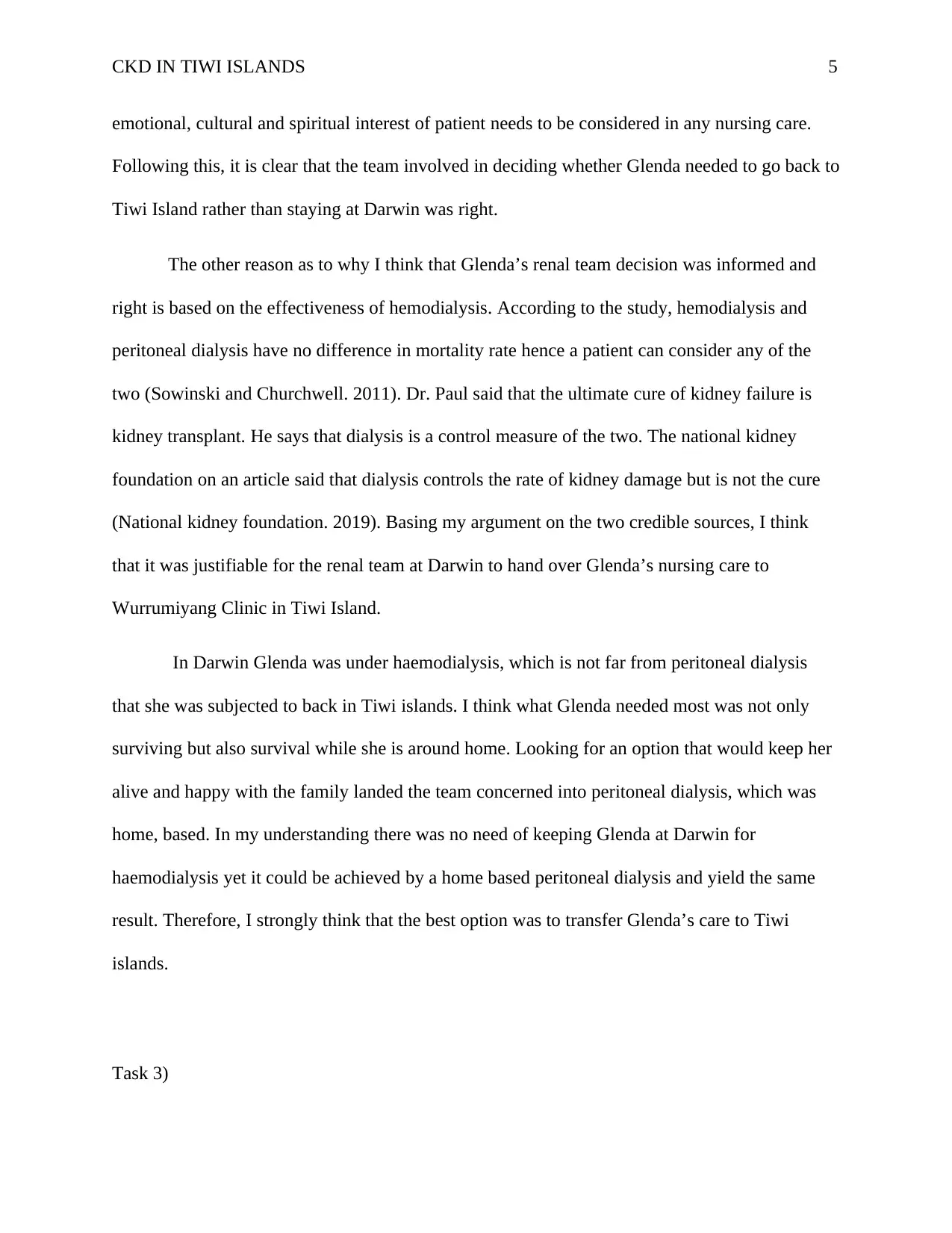
CKD IN TIWI ISLANDS 5
emotional, cultural and spiritual interest of patient needs to be considered in any nursing care.
Following this, it is clear that the team involved in deciding whether Glenda needed to go back to
Tiwi Island rather than staying at Darwin was right.
The other reason as to why I think that Glenda’s renal team decision was informed and
right is based on the effectiveness of hemodialysis. According to the study, hemodialysis and
peritoneal dialysis have no difference in mortality rate hence a patient can consider any of the
two (Sowinski and Churchwell. 2011). Dr. Paul said that the ultimate cure of kidney failure is
kidney transplant. He says that dialysis is a control measure of the two. The national kidney
foundation on an article said that dialysis controls the rate of kidney damage but is not the cure
(National kidney foundation. 2019). Basing my argument on the two credible sources, I think
that it was justifiable for the renal team at Darwin to hand over Glenda’s nursing care to
Wurrumiyang Clinic in Tiwi Island.
In Darwin Glenda was under haemodialysis, which is not far from peritoneal dialysis
that she was subjected to back in Tiwi islands. I think what Glenda needed most was not only
surviving but also survival while she is around home. Looking for an option that would keep her
alive and happy with the family landed the team concerned into peritoneal dialysis, which was
home, based. In my understanding there was no need of keeping Glenda at Darwin for
haemodialysis yet it could be achieved by a home based peritoneal dialysis and yield the same
result. Therefore, I strongly think that the best option was to transfer Glenda’s care to Tiwi
islands.
Task 3)
emotional, cultural and spiritual interest of patient needs to be considered in any nursing care.
Following this, it is clear that the team involved in deciding whether Glenda needed to go back to
Tiwi Island rather than staying at Darwin was right.
The other reason as to why I think that Glenda’s renal team decision was informed and
right is based on the effectiveness of hemodialysis. According to the study, hemodialysis and
peritoneal dialysis have no difference in mortality rate hence a patient can consider any of the
two (Sowinski and Churchwell. 2011). Dr. Paul said that the ultimate cure of kidney failure is
kidney transplant. He says that dialysis is a control measure of the two. The national kidney
foundation on an article said that dialysis controls the rate of kidney damage but is not the cure
(National kidney foundation. 2019). Basing my argument on the two credible sources, I think
that it was justifiable for the renal team at Darwin to hand over Glenda’s nursing care to
Wurrumiyang Clinic in Tiwi Island.
In Darwin Glenda was under haemodialysis, which is not far from peritoneal dialysis
that she was subjected to back in Tiwi islands. I think what Glenda needed most was not only
surviving but also survival while she is around home. Looking for an option that would keep her
alive and happy with the family landed the team concerned into peritoneal dialysis, which was
home, based. In my understanding there was no need of keeping Glenda at Darwin for
haemodialysis yet it could be achieved by a home based peritoneal dialysis and yield the same
result. Therefore, I strongly think that the best option was to transfer Glenda’s care to Tiwi
islands.
Task 3)
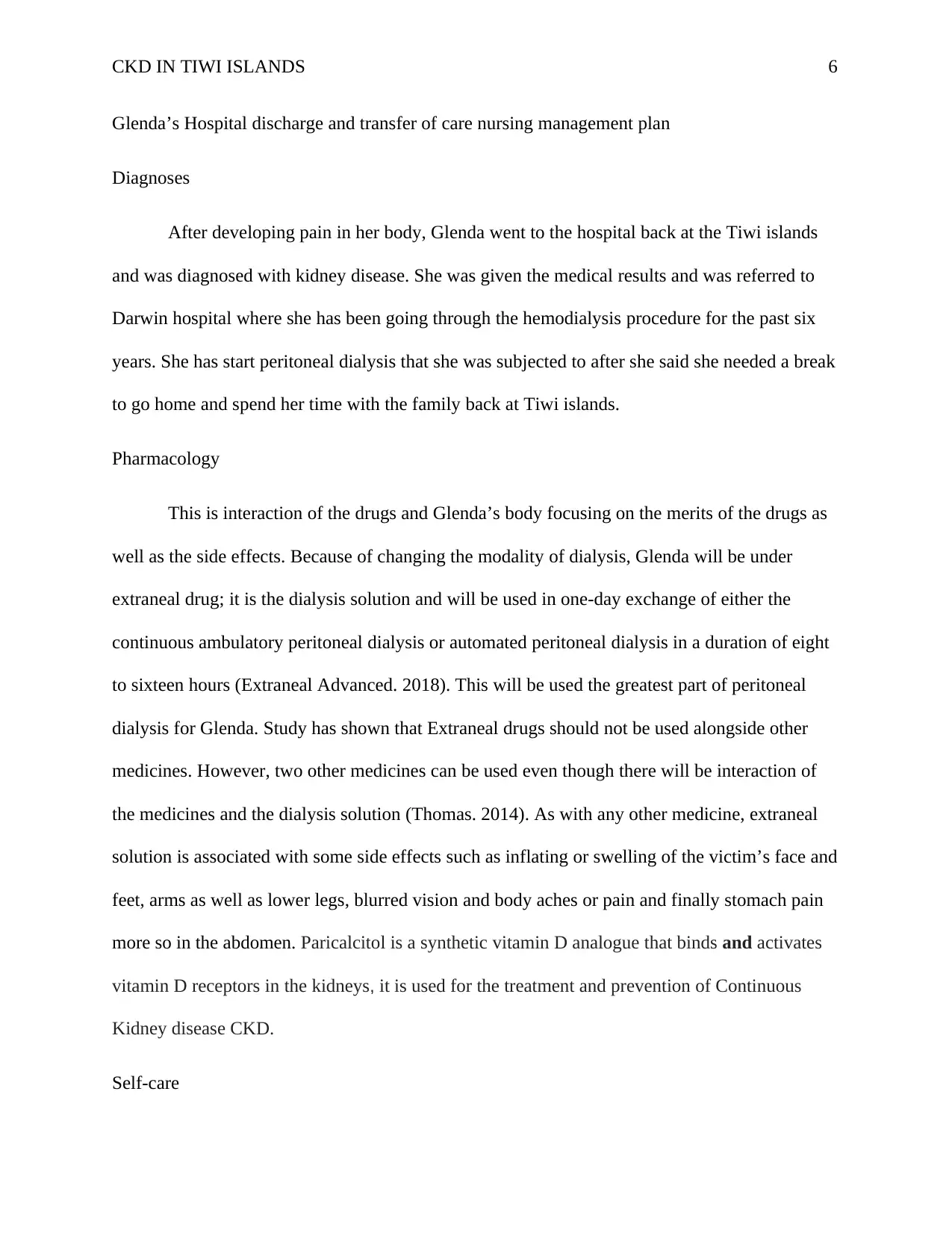
CKD IN TIWI ISLANDS 6
Glenda’s Hospital discharge and transfer of care nursing management plan
Diagnoses
After developing pain in her body, Glenda went to the hospital back at the Tiwi islands
and was diagnosed with kidney disease. She was given the medical results and was referred to
Darwin hospital where she has been going through the hemodialysis procedure for the past six
years. She has start peritoneal dialysis that she was subjected to after she said she needed a break
to go home and spend her time with the family back at Tiwi islands.
Pharmacology
This is interaction of the drugs and Glenda’s body focusing on the merits of the drugs as
well as the side effects. Because of changing the modality of dialysis, Glenda will be under
extraneal drug; it is the dialysis solution and will be used in one-day exchange of either the
continuous ambulatory peritoneal dialysis or automated peritoneal dialysis in a duration of eight
to sixteen hours (Extraneal Advanced. 2018). This will be used the greatest part of peritoneal
dialysis for Glenda. Study has shown that Extraneal drugs should not be used alongside other
medicines. However, two other medicines can be used even though there will be interaction of
the medicines and the dialysis solution (Thomas. 2014). As with any other medicine, extraneal
solution is associated with some side effects such as inflating or swelling of the victim’s face and
feet, arms as well as lower legs, blurred vision and body aches or pain and finally stomach pain
more so in the abdomen. Paricalcitol is a synthetic vitamin D analogue that binds and activates
vitamin D receptors in the kidneys, it is used for the treatment and prevention of Continuous
Kidney disease CKD.
Self-care
Glenda’s Hospital discharge and transfer of care nursing management plan
Diagnoses
After developing pain in her body, Glenda went to the hospital back at the Tiwi islands
and was diagnosed with kidney disease. She was given the medical results and was referred to
Darwin hospital where she has been going through the hemodialysis procedure for the past six
years. She has start peritoneal dialysis that she was subjected to after she said she needed a break
to go home and spend her time with the family back at Tiwi islands.
Pharmacology
This is interaction of the drugs and Glenda’s body focusing on the merits of the drugs as
well as the side effects. Because of changing the modality of dialysis, Glenda will be under
extraneal drug; it is the dialysis solution and will be used in one-day exchange of either the
continuous ambulatory peritoneal dialysis or automated peritoneal dialysis in a duration of eight
to sixteen hours (Extraneal Advanced. 2018). This will be used the greatest part of peritoneal
dialysis for Glenda. Study has shown that Extraneal drugs should not be used alongside other
medicines. However, two other medicines can be used even though there will be interaction of
the medicines and the dialysis solution (Thomas. 2014). As with any other medicine, extraneal
solution is associated with some side effects such as inflating or swelling of the victim’s face and
feet, arms as well as lower legs, blurred vision and body aches or pain and finally stomach pain
more so in the abdomen. Paricalcitol is a synthetic vitamin D analogue that binds and activates
vitamin D receptors in the kidneys, it is used for the treatment and prevention of Continuous
Kidney disease CKD.
Self-care
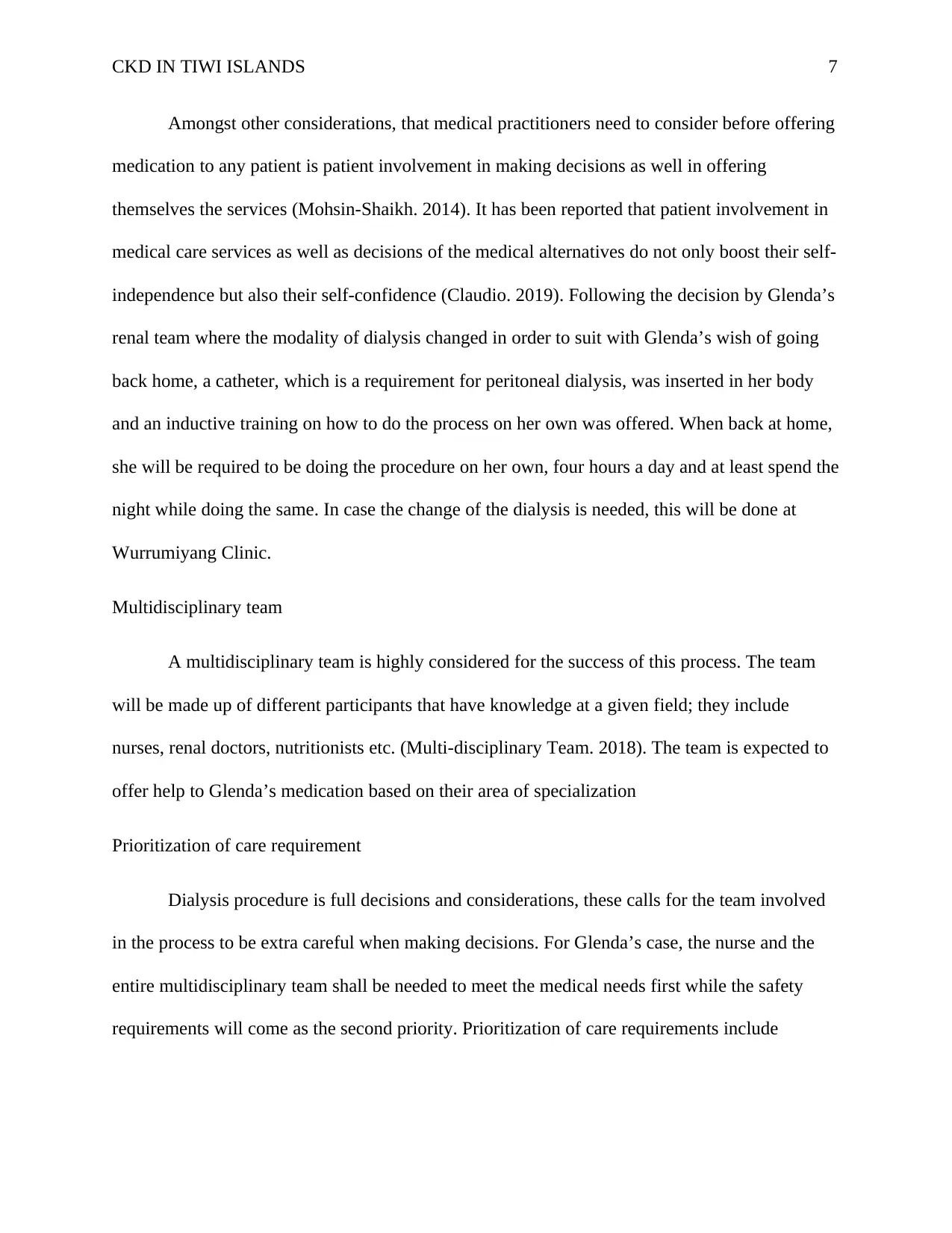
CKD IN TIWI ISLANDS 7
Amongst other considerations, that medical practitioners need to consider before offering
medication to any patient is patient involvement in making decisions as well in offering
themselves the services (Mohsin-Shaikh. 2014). It has been reported that patient involvement in
medical care services as well as decisions of the medical alternatives do not only boost their self-
independence but also their self-confidence (Claudio. 2019). Following the decision by Glenda’s
renal team where the modality of dialysis changed in order to suit with Glenda’s wish of going
back home, a catheter, which is a requirement for peritoneal dialysis, was inserted in her body
and an inductive training on how to do the process on her own was offered. When back at home,
she will be required to be doing the procedure on her own, four hours a day and at least spend the
night while doing the same. In case the change of the dialysis is needed, this will be done at
Wurrumiyang Clinic.
Multidisciplinary team
A multidisciplinary team is highly considered for the success of this process. The team
will be made up of different participants that have knowledge at a given field; they include
nurses, renal doctors, nutritionists etc. (Multi-disciplinary Team. 2018). The team is expected to
offer help to Glenda’s medication based on their area of specialization
Prioritization of care requirement
Dialysis procedure is full decisions and considerations, these calls for the team involved
in the process to be extra careful when making decisions. For Glenda’s case, the nurse and the
entire multidisciplinary team shall be needed to meet the medical needs first while the safety
requirements will come as the second priority. Prioritization of care requirements include
Amongst other considerations, that medical practitioners need to consider before offering
medication to any patient is patient involvement in making decisions as well in offering
themselves the services (Mohsin-Shaikh. 2014). It has been reported that patient involvement in
medical care services as well as decisions of the medical alternatives do not only boost their self-
independence but also their self-confidence (Claudio. 2019). Following the decision by Glenda’s
renal team where the modality of dialysis changed in order to suit with Glenda’s wish of going
back home, a catheter, which is a requirement for peritoneal dialysis, was inserted in her body
and an inductive training on how to do the process on her own was offered. When back at home,
she will be required to be doing the procedure on her own, four hours a day and at least spend the
night while doing the same. In case the change of the dialysis is needed, this will be done at
Wurrumiyang Clinic.
Multidisciplinary team
A multidisciplinary team is highly considered for the success of this process. The team
will be made up of different participants that have knowledge at a given field; they include
nurses, renal doctors, nutritionists etc. (Multi-disciplinary Team. 2018). The team is expected to
offer help to Glenda’s medication based on their area of specialization
Prioritization of care requirement
Dialysis procedure is full decisions and considerations, these calls for the team involved
in the process to be extra careful when making decisions. For Glenda’s case, the nurse and the
entire multidisciplinary team shall be needed to meet the medical needs first while the safety
requirements will come as the second priority. Prioritization of care requirements include
Paraphrase This Document
Need a fresh take? Get an instant paraphrase of this document with our AI Paraphraser
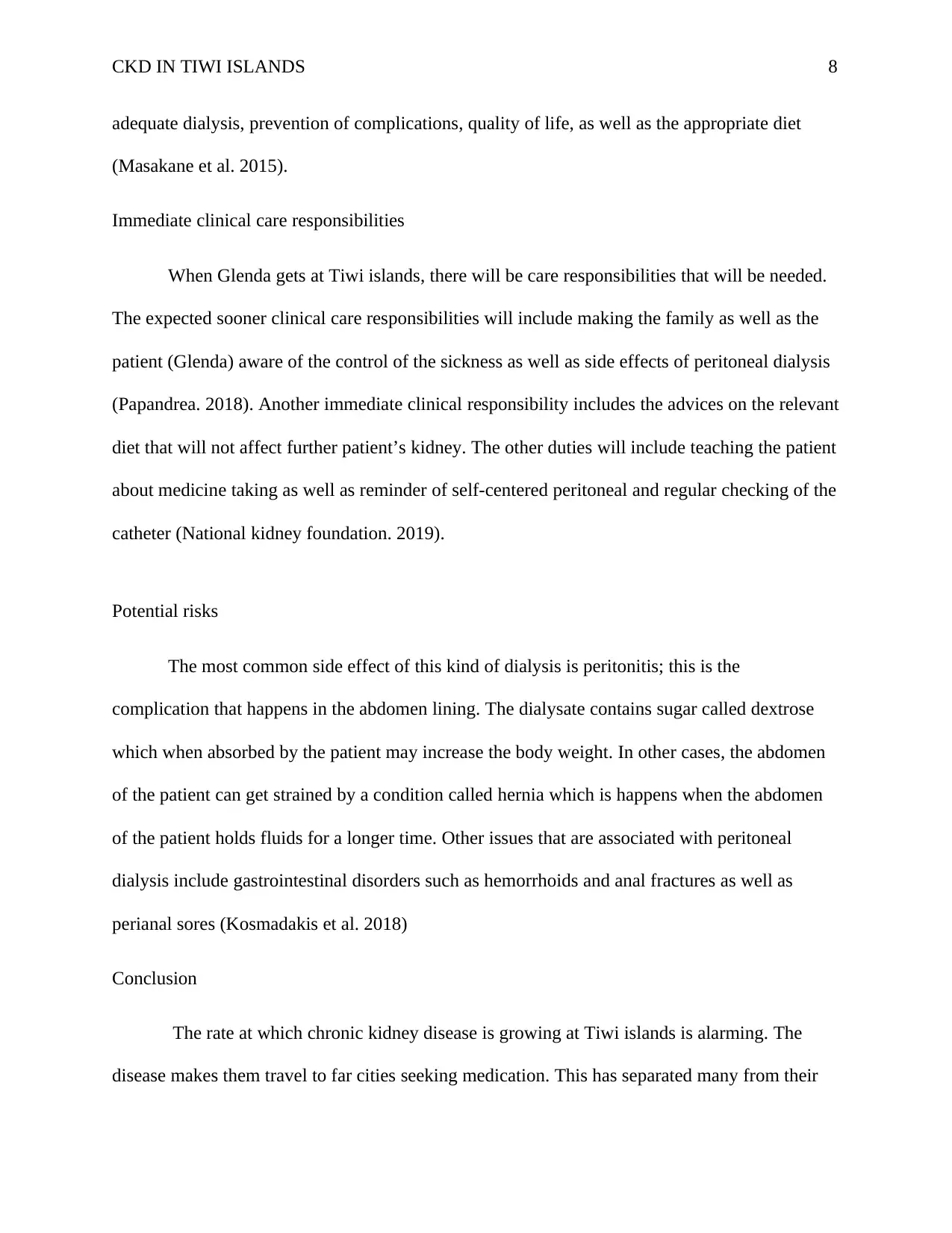
CKD IN TIWI ISLANDS 8
adequate dialysis, prevention of complications, quality of life, as well as the appropriate diet
(Masakane et al. 2015).
Immediate clinical care responsibilities
When Glenda gets at Tiwi islands, there will be care responsibilities that will be needed.
The expected sooner clinical care responsibilities will include making the family as well as the
patient (Glenda) aware of the control of the sickness as well as side effects of peritoneal dialysis
(Papandrea. 2018). Another immediate clinical responsibility includes the advices on the relevant
diet that will not affect further patient’s kidney. The other duties will include teaching the patient
about medicine taking as well as reminder of self-centered peritoneal and regular checking of the
catheter (National kidney foundation. 2019).
Potential risks
The most common side effect of this kind of dialysis is peritonitis; this is the
complication that happens in the abdomen lining. The dialysate contains sugar called dextrose
which when absorbed by the patient may increase the body weight. In other cases, the abdomen
of the patient can get strained by a condition called hernia which is happens when the abdomen
of the patient holds fluids for a longer time. Other issues that are associated with peritoneal
dialysis include gastrointestinal disorders such as hemorrhoids and anal fractures as well as
perianal sores (Kosmadakis et al. 2018)
Conclusion
The rate at which chronic kidney disease is growing at Tiwi islands is alarming. The
disease makes them travel to far cities seeking medication. This has separated many from their
adequate dialysis, prevention of complications, quality of life, as well as the appropriate diet
(Masakane et al. 2015).
Immediate clinical care responsibilities
When Glenda gets at Tiwi islands, there will be care responsibilities that will be needed.
The expected sooner clinical care responsibilities will include making the family as well as the
patient (Glenda) aware of the control of the sickness as well as side effects of peritoneal dialysis
(Papandrea. 2018). Another immediate clinical responsibility includes the advices on the relevant
diet that will not affect further patient’s kidney. The other duties will include teaching the patient
about medicine taking as well as reminder of self-centered peritoneal and regular checking of the
catheter (National kidney foundation. 2019).
Potential risks
The most common side effect of this kind of dialysis is peritonitis; this is the
complication that happens in the abdomen lining. The dialysate contains sugar called dextrose
which when absorbed by the patient may increase the body weight. In other cases, the abdomen
of the patient can get strained by a condition called hernia which is happens when the abdomen
of the patient holds fluids for a longer time. Other issues that are associated with peritoneal
dialysis include gastrointestinal disorders such as hemorrhoids and anal fractures as well as
perianal sores (Kosmadakis et al. 2018)
Conclusion
The rate at which chronic kidney disease is growing at Tiwi islands is alarming. The
disease makes them travel to far cities seeking medication. This has separated many from their

CKD IN TIWI ISLANDS 9
families and countries. Due to the love of her country, Glenda who spent six years in Darwin
hospital needed to go home a decision that was right according to me. In her transfer, she needed
the nursing handover and the management of care that she would follow in order to ensure
successful patient centered dialysis back in Tiwi islands.
families and countries. Due to the love of her country, Glenda who spent six years in Darwin
hospital needed to go home a decision that was right according to me. In her transfer, she needed
the nursing handover and the management of care that she would follow in order to ensure
successful patient centered dialysis back in Tiwi islands.
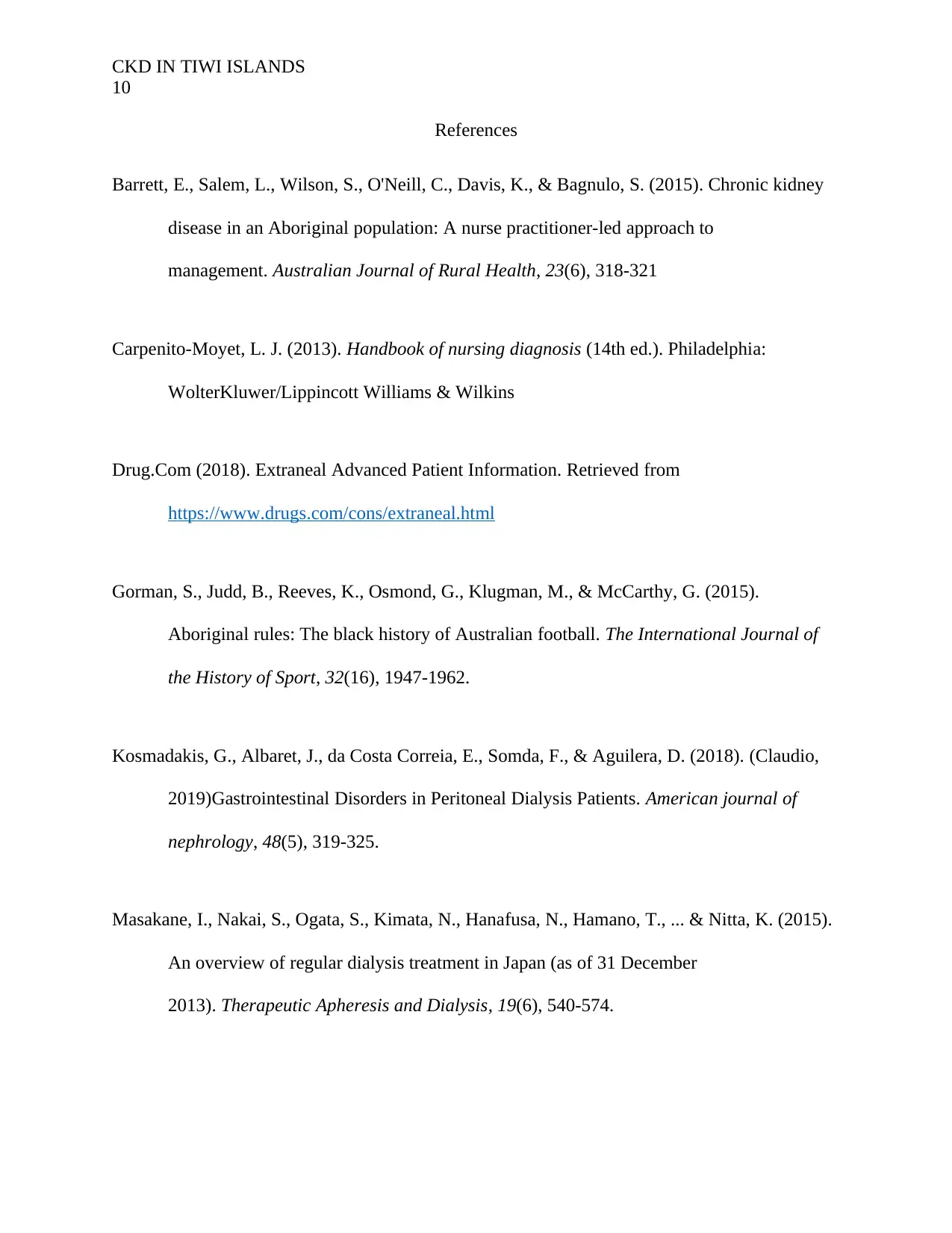
CKD IN TIWI ISLANDS
10
References
Barrett, E., Salem, L., Wilson, S., O'Neill, C., Davis, K., & Bagnulo, S. (2015). Chronic kidney
disease in an Aboriginal population: A nurse practitioner‐led approach to
management. Australian Journal of Rural Health, 23(6), 318-321
Carpenito-Moyet, L. J. (2013). Handbook of nursing diagnosis (14th ed.). Philadelphia:
WolterKluwer/Lippincott Williams & Wilkins
Drug.Com (2018). Extraneal Advanced Patient Information. Retrieved from
https://www.drugs.com/cons/extraneal.html
Gorman, S., Judd, B., Reeves, K., Osmond, G., Klugman, M., & McCarthy, G. (2015).
Aboriginal rules: The black history of Australian football. The International Journal of
the History of Sport, 32(16), 1947-1962.
Kosmadakis, G., Albaret, J., da Costa Correia, E., Somda, F., & Aguilera, D. (2018). (Claudio,
2019)Gastrointestinal Disorders in Peritoneal Dialysis Patients. American journal of
nephrology, 48(5), 319-325.
Masakane, I., Nakai, S., Ogata, S., Kimata, N., Hanafusa, N., Hamano, T., ... & Nitta, K. (2015).
An overview of regular dialysis treatment in Japan (as of 31 December
2013). Therapeutic Apheresis and Dialysis, 19(6), 540-574.
10
References
Barrett, E., Salem, L., Wilson, S., O'Neill, C., Davis, K., & Bagnulo, S. (2015). Chronic kidney
disease in an Aboriginal population: A nurse practitioner‐led approach to
management. Australian Journal of Rural Health, 23(6), 318-321
Carpenito-Moyet, L. J. (2013). Handbook of nursing diagnosis (14th ed.). Philadelphia:
WolterKluwer/Lippincott Williams & Wilkins
Drug.Com (2018). Extraneal Advanced Patient Information. Retrieved from
https://www.drugs.com/cons/extraneal.html
Gorman, S., Judd, B., Reeves, K., Osmond, G., Klugman, M., & McCarthy, G. (2015).
Aboriginal rules: The black history of Australian football. The International Journal of
the History of Sport, 32(16), 1947-1962.
Kosmadakis, G., Albaret, J., da Costa Correia, E., Somda, F., & Aguilera, D. (2018). (Claudio,
2019)Gastrointestinal Disorders in Peritoneal Dialysis Patients. American journal of
nephrology, 48(5), 319-325.
Masakane, I., Nakai, S., Ogata, S., Kimata, N., Hanafusa, N., Hamano, T., ... & Nitta, K. (2015).
An overview of regular dialysis treatment in Japan (as of 31 December
2013). Therapeutic Apheresis and Dialysis, 19(6), 540-574.
Secure Best Marks with AI Grader
Need help grading? Try our AI Grader for instant feedback on your assignments.
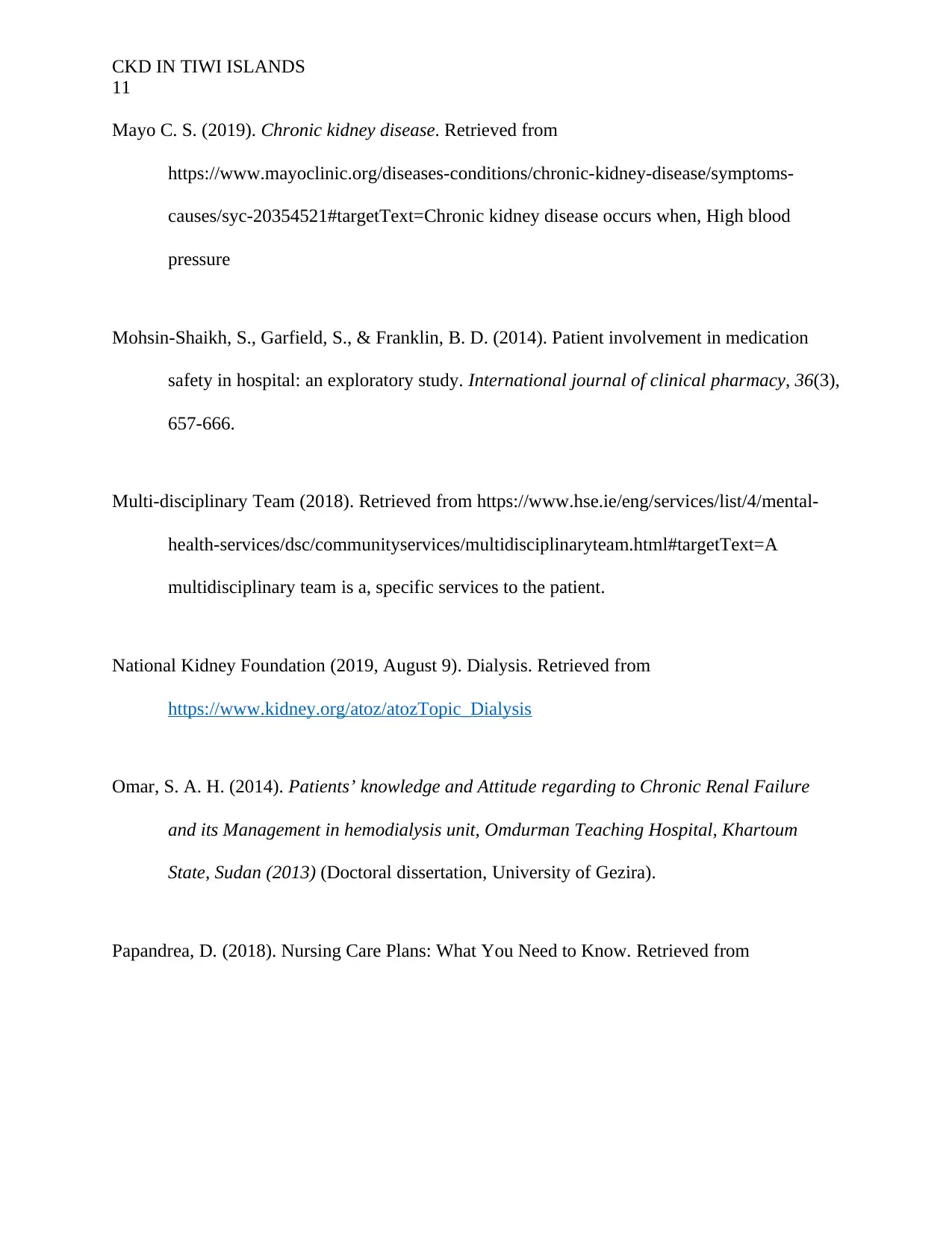
CKD IN TIWI ISLANDS
11
Mayo C. S. (2019). Chronic kidney disease. Retrieved from
https://www.mayoclinic.org/diseases-conditions/chronic-kidney-disease/symptoms-
causes/syc-20354521#targetText=Chronic kidney disease occurs when, High blood
pressure
Mohsin-Shaikh, S., Garfield, S., & Franklin, B. D. (2014). Patient involvement in medication
safety in hospital: an exploratory study. International journal of clinical pharmacy, 36(3),
657-666.
Multi-disciplinary Team (2018). Retrieved from https://www.hse.ie/eng/services/list/4/mental-
health-services/dsc/communityservices/multidisciplinaryteam.html#targetText=A
multidisciplinary team is a, specific services to the patient.
National Kidney Foundation (2019, August 9). Dialysis. Retrieved from
https://www.kidney.org/atoz/atozTopic_Dialysis
Omar, S. A. H. (2014). Patients’ knowledge and Attitude regarding to Chronic Renal Failure
and its Management in hemodialysis unit, Omdurman Teaching Hospital, Khartoum
State, Sudan (2013) (Doctoral dissertation, University of Gezira).
Papandrea, D. (2018). Nursing Care Plans: What You Need to Know. Retrieved from
11
Mayo C. S. (2019). Chronic kidney disease. Retrieved from
https://www.mayoclinic.org/diseases-conditions/chronic-kidney-disease/symptoms-
causes/syc-20354521#targetText=Chronic kidney disease occurs when, High blood
pressure
Mohsin-Shaikh, S., Garfield, S., & Franklin, B. D. (2014). Patient involvement in medication
safety in hospital: an exploratory study. International journal of clinical pharmacy, 36(3),
657-666.
Multi-disciplinary Team (2018). Retrieved from https://www.hse.ie/eng/services/list/4/mental-
health-services/dsc/communityservices/multidisciplinaryteam.html#targetText=A
multidisciplinary team is a, specific services to the patient.
National Kidney Foundation (2019, August 9). Dialysis. Retrieved from
https://www.kidney.org/atoz/atozTopic_Dialysis
Omar, S. A. H. (2014). Patients’ knowledge and Attitude regarding to Chronic Renal Failure
and its Management in hemodialysis unit, Omdurman Teaching Hospital, Khartoum
State, Sudan (2013) (Doctoral dissertation, University of Gezira).
Papandrea, D. (2018). Nursing Care Plans: What You Need to Know. Retrieved from
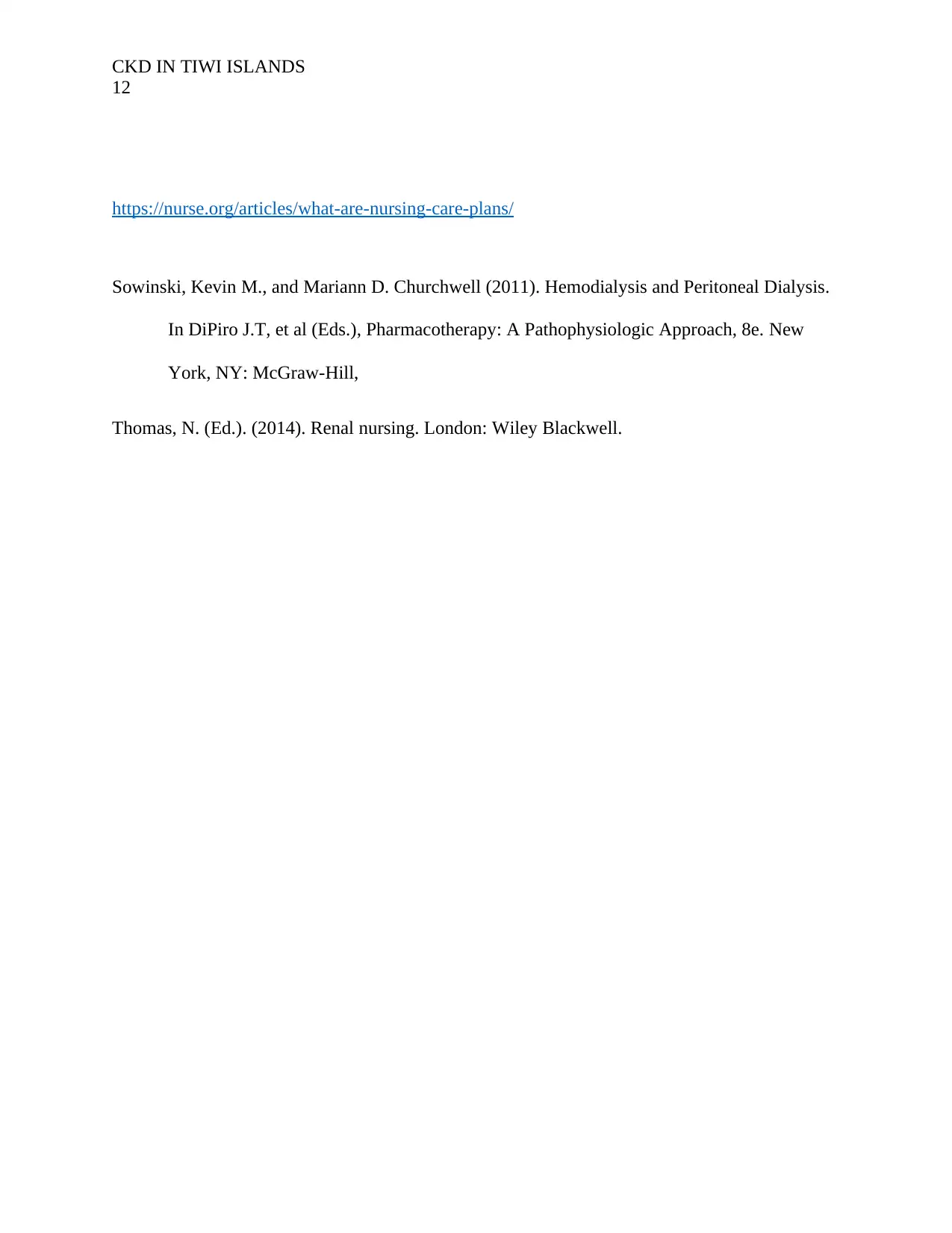
CKD IN TIWI ISLANDS
12
https://nurse.org/articles/what-are-nursing-care-plans/
Sowinski, Kevin M., and Mariann D. Churchwell (2011). Hemodialysis and Peritoneal Dialysis.
In DiPiro J.T, et al (Eds.), Pharmacotherapy: A Pathophysiologic Approach, 8e. New
York, NY: McGraw-Hill,
Thomas, N. (Ed.). (2014). Renal nursing. London: Wiley Blackwell.
12
https://nurse.org/articles/what-are-nursing-care-plans/
Sowinski, Kevin M., and Mariann D. Churchwell (2011). Hemodialysis and Peritoneal Dialysis.
In DiPiro J.T, et al (Eds.), Pharmacotherapy: A Pathophysiologic Approach, 8e. New
York, NY: McGraw-Hill,
Thomas, N. (Ed.). (2014). Renal nursing. London: Wiley Blackwell.
1 out of 12
Related Documents
Your All-in-One AI-Powered Toolkit for Academic Success.
+13062052269
info@desklib.com
Available 24*7 on WhatsApp / Email
![[object Object]](/_next/static/media/star-bottom.7253800d.svg)
Unlock your academic potential
© 2024 | Zucol Services PVT LTD | All rights reserved.



